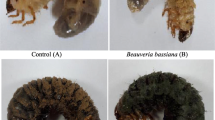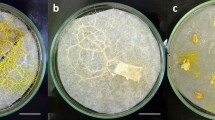Abstract
The survival of three isolates ofZoophthora radicans (NW 250, NW 253 & NW 182) as hyphal bodies in dried larvae ofPlutella xylostella stored at 4, 10 and 20°C and 20% R.H was determined. After storage at 20°C, the production of conidia by all isolates was unaffected after 2 weeks but diminished increasingly after 4 and 8 weeks and was entirely lost after 16 weeks. By comparison conidium production at 10°C was unaffected after 16 weeks (isolates NW 250 and NW 182) and, 24 weeks (NW 253) of storage though it declined rapidly in all isolates thereafter. At 4°C many conidia were produced by all isolates even after 34 weeks of storage. These results are consistent with work on other entomophthoralean fungi in dried cadavers suggesting that this may be a common survival strategy in these fungi. NW 250, 253 and 182 were isolated fromP. xylostella in Malaysia and Taiwan, where conditions allow the host to remain active throughout the year. None produced resting sporesin vivo orin vitro but as hosts are always available the ability to survive short dry periods is probably more important than long-term survival for which resting spores are most adapted.
Résumé
La survie des corps hyphaux de trois souches deZoophthora radicans (NW 250, NW 253 et NW 182) dans les cadavres secs de chenilles dePlutella xylostella a été étudiée à 4, 10 et 20°C et à 20% RH. Dans le cas du maintien à 20°C, la production de conidies des différents isolats n'est pas modifiée au bout de 2 semaines mais diminue progressivement après 4 et 8 semaines pour devenir nulle après 16 semaines. A 10°C, la production de conidies n'est pas modifiée au bout de 16 (souches NW 250 et NW 182) ou de 24 semaines (souche NW 253) de stockage, mais diminue ensuite rapidement pour les 3 souches. A 4°C, chaque isolat produit des conidies en quantités, même après 34 semaines de stockage. Ces résultats sont comparables à ceux concernant la survie d'autres Entomophthorales dans des cadavres d'insectes secs, ce qui donne à penser qu'il existe une stratégie commune de survie chez ces champignons. Les 3 souches étudiées deZ. radicans ont été isolées deP. xylostella en Malaisie ou à Taiwan; aucune ne produit de spores de résistancein vivo ouin vitro. Les conditions de la Malaisie ou de Taiwan étant telles que l'insecte-hôte est présent tout au long de l'année, la possibilité de survivre pendant de courtes périodes sèches est un caractère probablement plus important que l'aptitude à survivre à long terme qui caractérise les spores de résistance.
Similar content being viewed by others
References
Carson, F. T. — 1931. Control of relative humidity in a small enclosed space.Paper Trade J. 29, 71–74.
Cheng, E. Y. — 1988. Problems of control of insecticide-resistantPlutella xylostella.Pestic. Sci. 23, 177–188.
Johnson, C. A. — 1940. The maintenance of high atmospheric humidities for entomological work with glycerol-water mixtures.Ann. Appl. Biol. 27, 295–299.
Lim, G. S., Loke, W. H., Yusof, O. &Lim, B. K. — 1990. Strategies in diamondback moth management. In: “Management ofPlutella xylostella in Malaysia: Prospect & strategy” —M.A.R.D.I. Publication, Kuala Lumpur, Malaysia.
Kenneth, R., Wallis, G. Gerson, U. &Plaut, H. N. — 1972. Observations and experiments onTriplosporium floridanum (Entomophthorales) attacking spider mites in Israel.J. Invertebr. Pathol. 19, 366–369.
Kramer, J. P. — 1980. The house-fly mycosis caused byEntomophthora muscae: Influence of relative humidity on infectivity and conidial germination.New York Ent. Soc. LXXXVII, 236–240.
McCabe, D. & Soper, R. S. — 1985. Preparation of an entomopathogenic fungal insect control agent. U.S. Patent No. 4530834.
Newman, G. G. &Carner, G. R. — 1975. AnEntomophthora infection of the adult cluster flyPollenia rudis.J. Georgia Ent. Soc. 10, 315–326.
Ooi, P. A. C. — 1985. Diamondback Moth in Malaysia. In “Diamondback Moth Management”.N. S. Talekar & T. D. Griggs Eds), Proc. I Int. Workshop, Tainan, Taiwan, 11–15 March. p. 25–34.
Perry, D. F., Tyrrell, D. &Delyzer;A. J. — 1982. The mode of germination ofZoophthora radicans zygospores.Mycologia 74, 549–554.
Riethmacher, G. W., Rombach, M. C. & Kranz, J. In press. Epizootics ofPandora blunckii andZoophthora radicans in diamondback moth populations in the Philippines. In “Diamondback Moth”.N. S. Talekar & T. D. Griggs (Eds) Proc. II Int. Workshop, Tainan, Taiwan 10–14 December, 1990. 193–199.
Talekar, N. S., Lee, S. T. & Huang, S. W. — 1985. Intercropping and modification of irrigation method for the control of diamondback moth. In: “Diamondback Moth Management”.N. S. Talekar & T. D. Griggs (Eds) Proc. I Int. Workshop, Tainan, Taiwan, 11–15 March, 1985, p. 145–151.
Tyrrell, D. — 1988. Survival ofEntomophaga aulicae in dried insect larvae.J. Invertebr. Pathol. 52, 187–188.
Wilding, N. — 1973. The survival ofEntomophthora spp. in mummified aphids at different temperatures and humidities.J. Invertebr. Pathol. 21, 309–311.
Author information
Authors and Affiliations
Rights and permissions
About this article
Cite this article
Pell, J.K., Wilding, N. The survival ofZoophthora radicans (Zygomycetes: entomophthorales) isolates as hyphal bodies in mummified larvae ofPlutella xylostella (Lep.: Yponomeutidae) . Entomophaga 37, 649–654 (1992). https://doi.org/10.1007/BF02372336
Received:
Accepted:
Issue Date:
DOI: https://doi.org/10.1007/BF02372336




